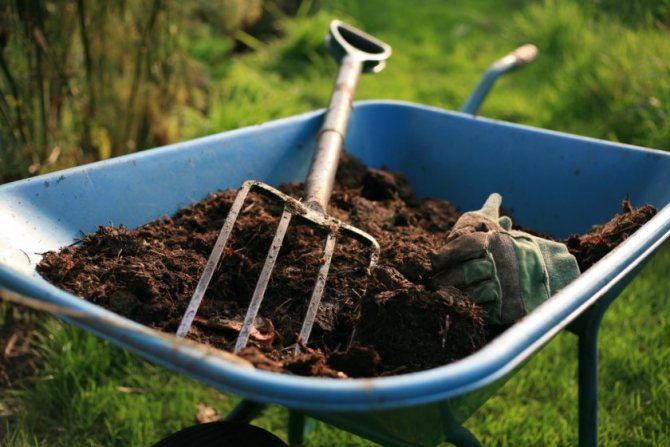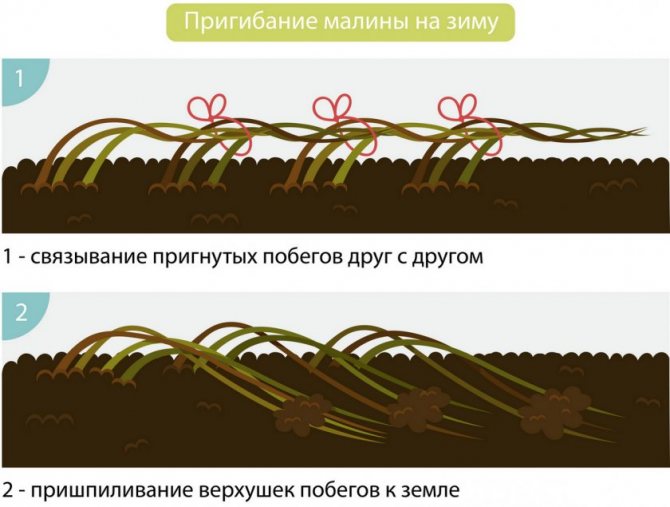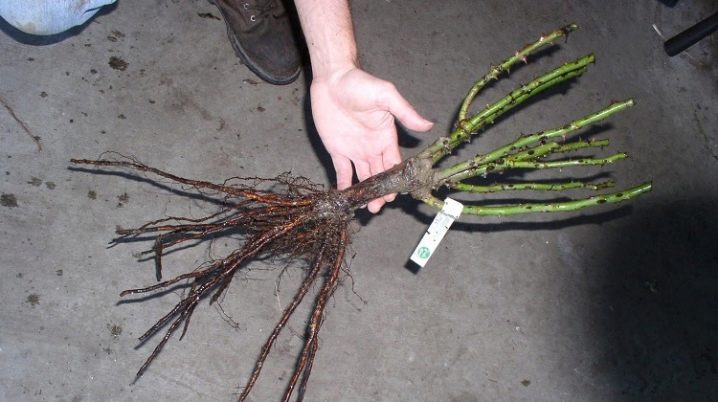Plant care
Caring for roses consists in timely watering, feeding, loosening the soil, mulching the root circle. Faded buds are cut off.
Watering rules and humidity
The amount of watering depends on the weather conditions. Rose reacts poorly to both lack and excess of moisture at the roots. Water the bushes after the top layer of the soil has dried. About 25 liters of water are poured under each plant.
To preserve moisture in the soil, the root circle is mulched. For this, peat, tree bark, compost are used. If there is enough rainfall during the summer, no additional watering is performed.

After watering, the soil under the roses is mulched with peat or compost
Top dressing and soil quality
The more fertile the soil, the higher the bushes will be, the brighter the inflorescences. Therefore, in early spring, the rose is fed with nitrogen, for example, urea. After 2 weeks, use ammonium nitrate.
At the stage of budding, a complex mineral fertilizer is introduced into the soil. The same composition is used after flowering. Potassium is used in late autumn, which contributes to the successful wintering of plants.
Pruning and replanting
Throughout the season, cut dry shoots broken from gusts of wind. Branches older than 4 years old are cut completely to the root. Young branches in the spring are shortened to 5 buds.
Faded buds are cut off. This increases the decorative effect of the rose, and also promotes its long flowering. The cuttings remaining after pruning can be used to propagate the rose. The culture is transplanted to the site in spring or autumn.
Features of wintering a flower
In mid-autumn, the bushes are watered abundantly with water. In warm regions, the Solita rose does not need shelter. The root circle needs to be mulched, covered with spruce branches. In the northern regions, the lashes are bent to the ground, a frame is erected around them, which is covered with agrofibre.
Growing
In what form is the landing
Well-developed rose bushes are planted in the ground. The best age for seedlings is 1-2 years. The older the plants, the worse they tolerate transplanting. The branches should not have dents, stains, or other signs of disease.
Important! It is necessary to pay attention so that the root system is developed, the roots are firmly held on the central shoot
What time is the boarding
In the southern regions, this variety is planted in the spring, in April or in May. Also, the crop can be planted in the fall, during October. In the northern regions, planting begins in the spring, after the onset of stable heat. Then the bushes have time to take root well before the onset of cold weather.
Location selection
Rose is a thermophilic plant. But she does not tolerate direct sunlight on the buds. The petals begin to fade, the plant loses its decorative appearance. Therefore, it is better to plant it in a well-lit place, but shaded for a few hot hours.
Important! Groundwater should not come close to the ground surface
How to prepare the soil and flower for planting
The rose prefers to grow in fertile soil. The soil should not be too heavy, but it should not allow moisture to pass through too quickly. Therefore, for weighting, a mixture of turf and clay is used, for relief - peat, compost, sand.
Too long roots and shoots are pruned. The root system is placed in a bucket of water for several hours. For disinfection, you can add several crystals of potassium permanganate there.

The rose is planted in such a way that the root collar is not too deep
Planting procedure step by step
Plant a rose on the site as follows way:
- Dig a hole measuring 60 × 60 × 60 centimeters.
- A drainage layer is laid out on the bottom.
- Then a 10-centimeter layer of rotted manure is poured.
- Pour out fertile soil.
- A seedling is placed in the middle, covered with soil.
The rose is watered abundantly, the root circle is covered with mulch.
Important! The root collar of the seedling should be 3 centimeters below ground level
Landing features
Heritage raspberries should be planted away from wild berries, otherwise there will be a risk of the spread of pests and diseases in the raspberry tree.
Recommended timing
The varieties of remontant raspberries are most often planted in the fall by residents of warm regions. It is necessary to calculate the planting time so that the raspberry bush takes root before frost. In the spring, the residents carry out the planting, where winter comes early. This must be done before bud break.
Choosing a place and seedlings
The planting site must be sunny for good performance. Wet, windy planting sites should be avoided as raspberries do not like to stand in water. Drying the plant in strong winds will negatively affect the yield and taste of the berries. Growing raspberries requires a rich and well-drained soil, neutral to slightly acidic, with a pH of 6.5 to 5.5.

By purchasing Heritage raspberry seedlings in a specialized store or nursery, you can get a guarantee that the purchase will correspond to the declared variety. It is better to buy biennial plants, you can ignore the size of the trunk.
Important! If the plant grows in partial shade, then the harvest will be poor, and the berries will be sour. You should carefully examine the seedling for the presence and number of shoots. There should be two of them
Each growth should be about 1 cm thick.A healthy seedling should have a central root shoot at least 15 cm in length and have multiple branches.
There should be two of them. Each growth should be about 1 cm thick.A healthy seedling should have a central root shoot at least 15 cm in length and have multiple branches.
You should carefully examine the seedling for the presence and number of shoots. There should be two of them. The thickness of each growth should be about 1 cm. In a healthy seedling, the central root process should be at least 15 cm in length and have multiple branches.
Preparation of planting material
Before planting raspberry bushes, you need to prepare the soil. Enrich with a 10 cm layer of compost (from peat moss, crushed waste from lemon trees, pine needles and oak leaves) or seasoned manure a couple of weeks before planting.

Raspberries respond well to application to the soil before planting with phosphorus fertilizers - 65 g per 1 m² and potassium sulfate - 40 g per 1 m². The site must be loosened and weeds periodically cut out.
Landing scheme
Heritage raspberry seedlings are sometimes sold in pots. With this purchase option, you will only need to immerse the plant in water for a couple of hours. After that, you need to hold the root of the seedling in a clay mash.
Did you know? There are over 200 species of raspberry, however only a few are grown commercially.
Planting process:
dig a 40 × 40 cm hole large enough to spread the roots
When planting several seedlings, it is recommended to maintain a distance between rows of about 150 cm, and 70 cm between holes; when planting a seedling, you need to pay attention so that the root collar rises about 4 cm above the soil surface. Then cover with a layer of loose soil; trample the soil from above by making a side; water each bush with about three buckets of water; shoots must be cut so that their length remains about 30 cm; after soil shrinkage, add additional soil filling

Follow-up care
Any plant requires regular maintenance. To get a decent harvest, you must perform the mandatory manipulations:
- Water in a timely manner. This type of remontant raspberry loves moist soil.
- Cut off unnecessary shoots in time.
- Tie up the shrub if necessary.
- Feed the soil.
- Carry out preventive measures to combat harmful insects and diseases.
- Mulch the near-stem circle.
- Prepare shelters for the winter period.

Preparation for wintering
In the first half of October, they begin to prepare the soil in the raspberry forest for winter. It should be dug up between the rows to a depth of 15 cm or loosened well.
According to gardeners, the raspberry shoots left for a double harvest are bent to the ground before the winter period, tied in a bunch, and then fixed with metal or wooden clamps, or tied to a wire. It is pulled at a level of 35 cm from the soil surface.

For shelter, roofing material, film or spunbond are used. If raspberries are grown for 1 harvest, then after pruning, mulching material is poured onto the shrub: a 10-centimeter layer of humus, sawdust or peat mixture. Neither straw nor foliage is suitable for shelter, since this is a good dwelling for rodents.
Description of rose Salita
The flower was bred by a German company, which became the nursery founded in the 19th century by the gardener Wilhelm Cordes.
Characteristic:
- orange-red buds;
- stem with 2–5 flowers 9 cm in diameter;
- an escape not exceeding 300 cm in height and 150 cm in width;
- landing time - April or end of October;
- resistant to powdery mildew.
The plant can withstand frosts down to -26 ° C and blooms continuously from June to November.
A distinctive feature of the bush - flower stalks are formed both at the top and at all levels of the shoot.
Disadvantages:
- slow growth, blooms in late August;
- instability of the rose to fungi.
With careful care, the disadvantages of the plant are redeemed by its merits.
Growing features
In the nursery, select seedlings with healthy roots and grafts. The best choice is domestic or Dutch varieties.
Choose a location that is well lit during the day for planting. It is imperative that there is drainage for the waste of excess moisture and the introduction of organic fertilizers.
Plant roses in mid-May. Dig up the earth to a depth of no more than 25 cm, add humus, compost or ash. Place medium-sized flowers at a distance of 0.5 m from each other, and tall ones - at least 1 m. Place the bush by grafting to the east. Water the roses once a week, soaking the soil 50 cm deep. Mineral dressing for 1 year is applied once a month with one of the following components:
- bird droppings in a ratio of 1: 20;
- mullein solution in a ratio of 1: 10;
- ash diluted in water;
- herbal infusion.
In the 2nd year after planting roses, feed at least 6 times during the season:
- at the beginning of spring - 20 g of carbamide diluted in 10 liters of water;
- after 2 weeks - 30 g of ammonium nitrate dissolved in 10 liters of water;
- apply complex mineral fertilizer before bud formation;
- when unblown buds appear, use ready-made organic fertilizer or mullein solution;
- when the bush has faded - complex mineral fertilizer;
- at the end of summer - a solution of 20 g of superphosphate in 10 l of water and 10 g of potassium salt in 10 l of water.
To keep your rose bushes in full bloom, prune them properly. Be sure to remove dry branches and those that are more than 4 years old. At least 5 buds remain on the shoot, which will give a rich color in the future.
In the middle of autumn, roses should be prepared for the cold weather. Bend them to the soil, treat with fungicides. Dry shavings, sawdust will serve as a shelter for a bush for the winter, huddle up to 12 cm in depth.
Caring for garden roses is simple, following all the recommendations, you will get a lush and beautiful garden.
Description and characteristics of Salita
Salita climbing rose was bred in 1987 by the German company Kordes. The bushes can grow up to 3 m in height, up to 1.5 m in width. The flowers are large, up to 9 cm in diameter, grow one at a time or on a brush up to 5 pieces. Peduncles are formed not only at the top of the shoots, but also at the very bottom of the branch. Orange-red flowers, double, shaped like hybrid tea roses.The leaves of the plant are large, shiny. An adult flowering shrub looks very beautiful,
Rose Solita blooms continuously, until autumn.

The climbing rose of the Salita variety has inherited all the best qualities of the Cordes roses:
- dense double flowers of large size;
- abundant and long flowering;
- winter well;
- powerful leaves resistant to diseases and many pests.

Faded flowers are regularly cut to stimulate subsequent flowering.
Landing
Agrotechnical technologies for growing a climbing rose do not differ from any other garden rose.
Prepare for planting seedlings in advance. Roses love light and do not tolerate drafts well, For them they choose a bright place, without stagnation and close occurrence of subsoil waters.
The best time to plant shrubs in spring is that by winter they will get stronger and can more easily survive frosts.
Rose prefers light fertile soil. If possible, the earth is dug up in a few weeks and fertilized. For acidic soil add dolomite flour.
They retreat from the wall by 35-50 cm.The holes are dug 50 × 50 cm in size, the distance between the plants is 80-100 cm.
Before planting seedlings in the ground, they are kept in water for several hours, and the roots and shoots are cut to 20-30 cm. This method helps to form a powerful root system.
In order for the plant to develop well, the soil between the roots is well compacted. The inoculation site is buried 5-7 cm into the ground.
The growth rate of the shrub is not high. The cooler the climate, the slower Salita grows. This feature allows the growths to ripen better, and it is easier to tolerate frost increases. Gardeners use this property when growing them in scrubs,
Further care
Water the plants once a week, after the topsoil has dried. Roses have a powerful root system that is able to provide the shrub with moisture.
It is better to water them with settled water from containers under the root.
It is not necessary to feed them in the first year of growth; feeding begins in the second year of development.
In spring, nitrogen fertilizers are applied for the growth of stems and leaves. In summer and autumn - phosphorus and potassium without nitrogen.
Trimming the stems is carried out to give the bushes the desired shape. Rejuvenation of old lashes on climbing roses is carried out no more than once every four years.
For roses to look beautiful and healthy, they need prevention and control of pests and diseases. The trunk circle is covered with mulch - this helps to reduce the incidence of fungal infections. The plant has an average resistance to fungal infections and if they are well looked after, they rarely get sick.
Roses are hardy plants and many species can withstand very cold temperatures.
There are many options for their shelter, and they depend on the characteristics of the climate in a particular region. For shelter for the winter, the stems are removed from the support, gradually bent to the ground and not obedient branches are pinned. The stems are not laid on bare ground. Unripe shoots are cut off and the ground around the trunk is covered with sawdust, peat, straw or coniferous spruce branches. A frame is being built for the covering material, under which the lashes of the plants are hidden.
Climbing roses go well with various architectural structures, therefore they are used as a living decoration of the garden. Salita rose, which grows with a scrub, will look great against the background of conifers, which often decorate flower beds.
Landing
You can start solving the problem in question in April, May or in the last decade of October. The second option is less preferable, since a young plant needs time to take root before frost, which is not always the case. Preparatory measures are carried out a day before planting and involve the removal of damaged areas of the plant's root system. In addition, experts recommend processing the latter with a biostimulant dissolved in water, which contributes to the adaptation of a young rose in a new place.

The order of further actions is as follows:
dig a hole, the depth of which is 40–60 cm and place a drainage layer on its bottom (about 10 cm of gravel or gravel);
if the owner of the site plants several roses of the described variety, it is advisable for him to maintain a meter distance between them;
apply organic fertilizers - rotted manure or a combination of mature compost and peat (recommended thickness - 10 cm);
position the seedling at an angle of 30 ° to the support, gently spread the roots and cover them with soil, carefully compacting it;
make sure that the root collar is 3 cm below ground level;
water the young plant thoroughly.


The final stage is mulching the soil with peat in the near-trunk circle.
Coleria: varieties and photos
The delight of amateur flower growers is caused by its bright, fluffy flowers, close to bells in shape. The color varies from pale pink to maroon, with the presence of colored blotches (strokes, dots, patterns).
Some species (ampelous) are grown in pots. Velvet leaves can be small or with large teeth, more often - a dark green color.
The ampallang coleria is distinguished by its fuchsia color, white-yellow petals and a straw. The decoration is a purple speck. The green leaf has dark streaks.
The fluffy coleria (eriantha) has increased velvety, reddening along the edging. Large flowers are red or orange in color, with a yellowish speck at the bottom.
Coleria queen victoria is beautiful. The flower looks like a red pipe. The outer petals are pink, and the inner ones are white with a pinkish border and dark beetroot patterns.
Coleria Lindeniana has velvety dark green leaves that are covered with silver fluff. The flowers are lilac on the inside and white on the outside.
Coleria sunshine is distinguished by small juicy pink flowers, yellowish-green pharynx and purple dots.
Coleria bibbi has large pink-scarlet flowers with whitish petals. Cherry blotches and yellow throat adorn the view. The strongly pubescent leaves have a calm green color.
The flashdance coleria is notable for its large coral flowers. The tube and petals are white-yellow. The risks are pinkish.
The variety Bogotskaya koleriya (bogotensis) has whitish hairs on the leaves. Consists of scarlet inflorescences (one or two). Mid orange with red stripes.
Coleria brimstone stands out for its cherry-yellow flowers and white tubule. The decoration is a cherry splash. The variety has elongated leaves with fluff.
Coleria jester has large white-purple flowers and a white tube. Pink specks are scattered throughout the kaleria. The dark green leaves shimmer with bronze.
Coleria clytie. The large pink-red flowers of the plant have a yellowish tube and whitish petals. Pattern - cherry strokes. Light green leaves with a pattern.
Kolleria Varshevich is distinguished by large variegated pink flowers, as well as a salad tube and petals. The decoration is cherry dots.
The majestic coleria (magnifica) delights everyone with huge flowers that look like bells. Color - orange-burgundy, blotches - scarlet. The leaves resemble a quilted bedspread, with a white pile on one side.
Bright scarlet hairy color (hirsuta) is covered with thick pile on the outside. The inner lilac-pinkish canvas has burgundy touches. The leaves, dark green with a bronze tint, have whitish hairs.
Spikelet (spicata) has long leaves with a silvery "bloom". The scarlet flowers have an orange color.
The digitaliflora variety has a thick whitish downy. The light green leaves, which are up to 20 cm long, have charming red villi. The flowers resemble a small barrel. The outer color is dominated by white (in the middle - greenish, with purple risks).
Coleria uneven (inaequalis) is a miniature variety. The pale burgundy flowers have an elongated shape. The pharynx is decorated with purple strokes.
Pleasant (amabilis) coleria stands out with crimson or pink flowers that look like tubes and a whitening throat. Large variegated leaves have chestnut veins and silver marks.
The tubiflora variety (tubiflora) is noticeable by the elongated flower shape. The tone is orange. The pharynx has scarlet strokes. The leaves are the color of a succulent grass.
Woolen coleria (lanata) has an unusual flower color: a beige tube and brown veins. The petal is whitish inside with reddish strokes. Small leaves have brown pubescence.
Coleria fluffy-flowered, pubescent-flowered (eriantha) has a bright red or orange color. The pharynx is yellow with spots. Emerald leaves have a dark red edging.
Diseases, pests and ways to control them
Rose Salita has good immunity, but under unfavorable growing conditions, it can be affected by fungal diseases. This can be avoided by thinning the crown, preventing waterlogging of the soil, removing plant residues from the root circle in autumn.
For prevention and treatment, antifungal drugs are used. Aphids and spider mites can take a fancy to the rose. Insecticides are used against harmful insects.
Important! During the flowering period, only biological preparations are used to spray roses. Salita is a climbing rose variety that is easy to grow in the garden.
It is unpretentious in care, frost-resistant. It needs to be watered, fed, cut off the faded buds on time. With the correct implementation of agrotechnical measures, the flowering of a rose can be admired from the end of May to mid-September.
Salita is a climbing rose variety that is easy to grow in the garden. It is unpretentious in care, frost-resistant. It needs to be watered on time, fed, cut off the faded buds. With the correct implementation of agrotechnical measures, the flowering of a rose can be admired from late May to mid-September.
vote
Article Rating
Plant care
Climbing rose Schneewalzer requires special care. It consists in timely watering, loosening, weeding, feeding, pruning excess shoots and preventing diseases.
Watering rules and humidity
The rose bush loves moisture, but does not tolerate stagnant water at all. Water it only when the soil is dry enough. In dry weather, watering is carried out twice a week. One bush requires up to 20 liters of warm water. In August, watering is reduced, and with the onset of autumn, it stops altogether.
How it weaves
Important! When watering for the first time, it is recommended to add growth stimulants such as heteroauxin or phosphobacterin to the water.
Top dressing and soil quality
In the spring, fertilizing is introduced in the form of nitrogenous fertilizers. During the flowering period, they stop, replacing it with one that contains phosphorus and potassium. In August, feeding stops altogether so that the Schneewalzer bush has time to prepare for winter.
It should also be noted that no feeding is applied in the first year. For a rose, the substrate laid in the planting pit is enough. Fertilization starts only next year.
Roses are very demanding on the soil. They need fertile and breathable soil. Moisture and air are better supplied to the roots if the soil at the planting site is light and loose.
Pruning and replanting
Pruning of the climbing variety is carried out during the entire growing season of the plant. In the spring, frail shoots, the top and those parts that have suffered from frost are removed. In summer, pruning is carried out weak, removing only faded buds. In the fall, they get rid of sick and damaged shoots, and also thin out overgrown bushes. Such pruning is also called sanitary.
Important! Once every 4-5 years, the bush is rejuvenated. To do this, almost everything is cut off, leaving 2-4 buds on the shoots.
Features of wintering a flower
Depending on the region of planting roses, they begin to cover it in October-November. To do this, press all the lashes with arcs to the ground, and then lay the covering material on top.Even in Siberia, the Schneewalzer rose can winter well if there is a thick snow cover. But it is imperative to cover the bush for the winter.
Use in landscape design
First of all, the Salita rose is intended for vertical gardening. Thanks to its impressive decorativeness, it can effectively decorate the wall of a building, fence, arch or gazebo. In addition, this variety looks great on poles and columns due to its abundant flowering at several levels. An alternative solution is to position the plant on the lawn. Combinations of "Salita" with ground cover annuals decorated with snow-white flowers look especially advantageous. If the owner of the rose wants to grow it with a scrub, he should create a suitable background from dark green foliage or needles. Given the size and appearance of the bushes of the variety in question, you should not be surprised that they allow you to realize the most daring design ideas. "Salita" suits the overwhelming majority of connoisseurs of beauty and originality, who want to refine their site and admire the result every year.


How the Salita rose blooms, see the video below.


